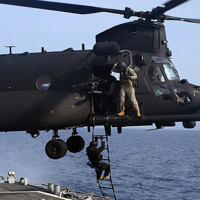A month after the mission that killed Osama Bin Laden, defense analysts are pointing to a growing collaboration between conventional and irregular forces and are calling for a lighter global military footprint, one based on raiding and strike capability rather than ponderous presence. The newfound enthusiasm for "collaborative warfare" is reviving a concept once thought dead: network-centric warfare (NWC).
Paradoxically, NWC has proved itself well-suited to low-intensity operations and the culture of special operations forces, where once it was commonly associated with high-intensity conflict against a peer competitor. But NWC's low-intensity revival also suggests that it will continue to face significant conceptual and practical obstacles to its conventional implementation.
Few agree on a common definition of NWC. There is the historical concept of NCW, which Navy analyst Norman Friedman argues simply means more information processed at higher speeds. There is the concept laid out by Vice Adm. Arthur K. Cebrowski, who famously argued (.pdf) that the military ought to shift away from singular platforms to systems -- an argument buttressed by his use of early 1990s corporate logistics and computing as role models from the civilian domain. And University of Utah professor Sean Lawson argues that Cebrowski's innocuous version of NWC was later perverted into a hubristic and technocentric military doctrine intended to underlay a strategy with unlimited aims.

